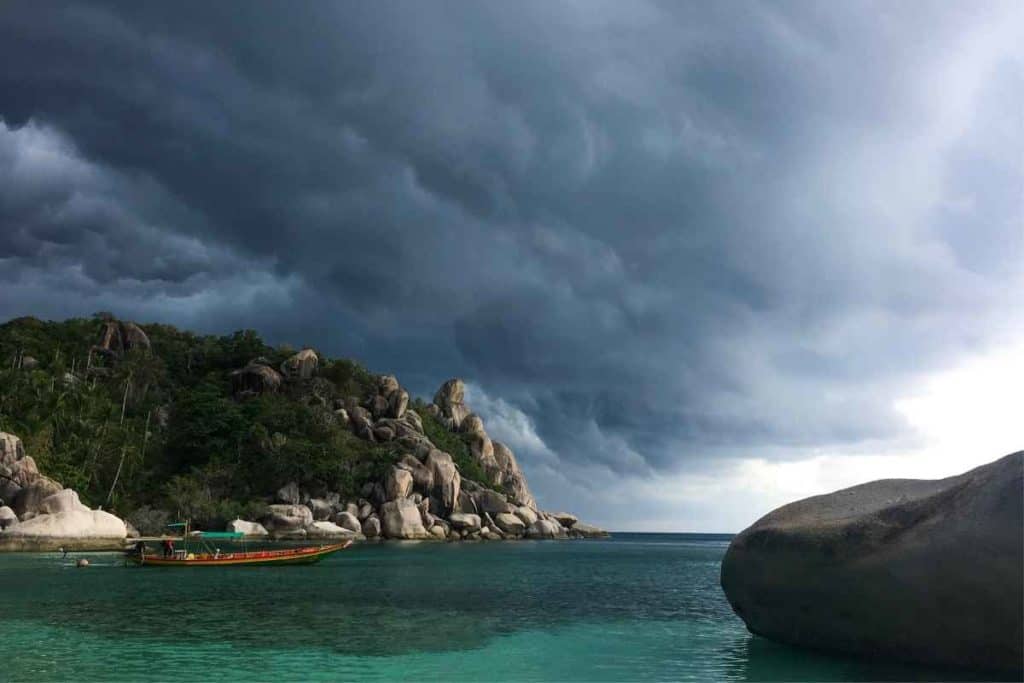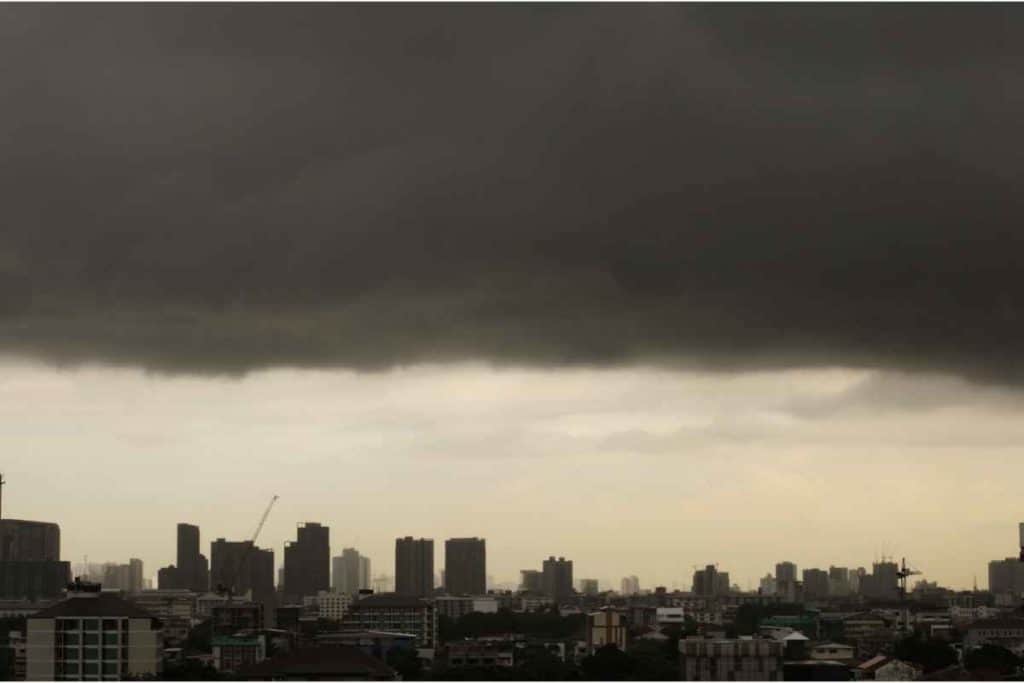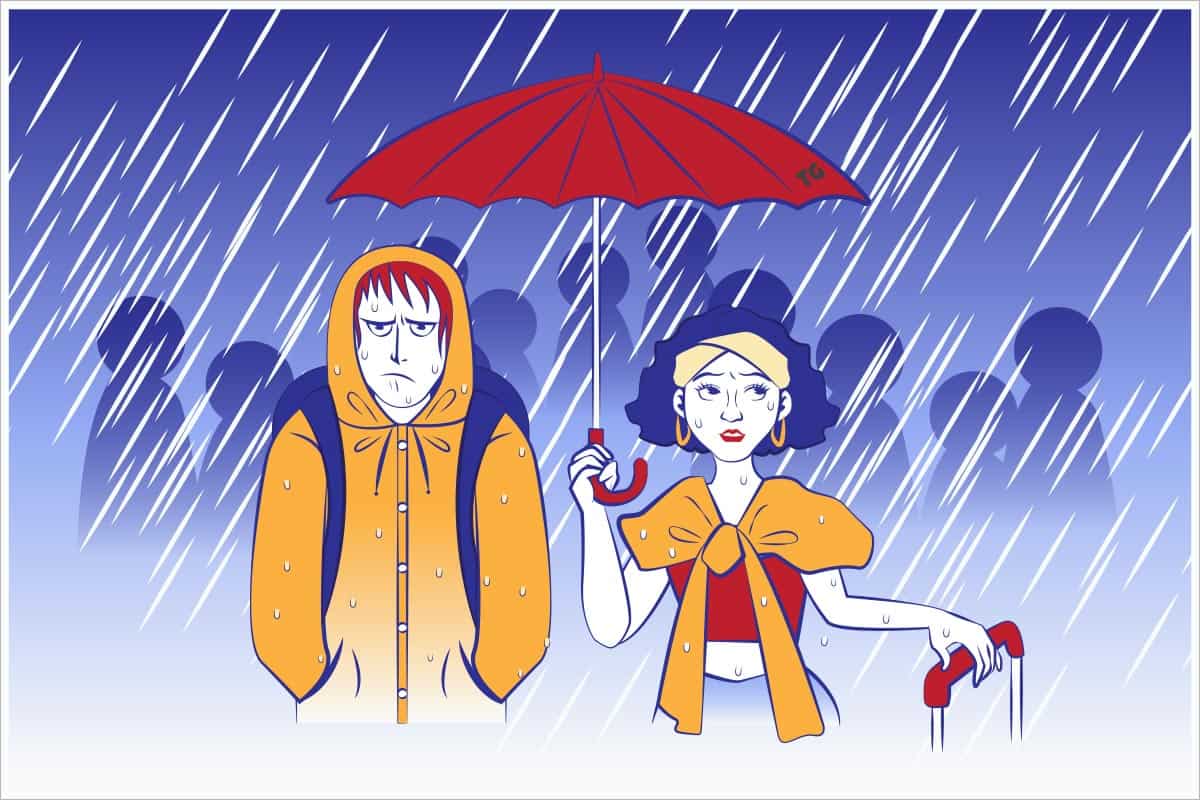Uniquely, Thailand does not follow the four reliable winter, spring, summer, and autumn seasons. Sticking to a uniform temperature of three seasons being hot, not-quite-so-hot, and wet – this coincides with a tropical monsoon season in Thailand (2).
With sweeps from the Indian Ocean and moist air heading towards the northeast, Thailand is sucked into the Southeast Asian tropical rain belt, also called the Inter Tropical Convergence Zone (or ITCZ for short) (2).
The most rainfall in Thailand occurs from August to October, depending on the provinces in the region. With typical rain beginning in July until October, you can still expect to have a good time but under unpredicted planning. May and June receive extra rain, leading to the official monsoon season.
The timing of the monsoon season cannot be easily predicted or reliable. However, it is easily noticed that some provinces, such as Chiang Mai, do not receive the same rainfall as Bangkok city or the Gulf of Thailand islands.
The annual and well-known celebration of Songkran in April usually marks the end of the hot summer season and the start of the wet season (2).
What Is A Monsoon and When Is The Rainy Season in Thailand?

Monsoon is regarded as the period of time when the winds bring in moisture from the Indian Ocean to the Southeast Asian Subcontinent (1). Bringing in humidity and tropical storms, temperatures range from high 89°F/32°C and 78°F/25°C.
April being the hottest month of Thailand, is soon swept away with rainy weather (1). Most rainfall occurs from August to September, bringing in large waves and frequent storms, thus preventing swimming or water sport activities. With scheduled timings, hotels and staff plan such activities at specific timings. Even then, weather plays its own course.
Between the three heavy months of rain, you will experience quite a few differences. August brings in unpredictable rain; it could look like it will storm, but you will end up with a few raindrops (1).
On other days, the rain will not stop at all. August remains the worst month to visit Chiang Mai, the city that experiences the most rainfall during that time. On the other hand, September still seems to be far worse; heavy lightning and thunder occur daily, being extremely unpredictable compared to August (1).
The South of Thailand would receive a mixture of heavy and light rain while Central and Northern Thailand are hit with heavy morning rain and light showers throughout the day.
Unlike August and September, October rain is more predictable (1). Heavy and relentless rain usually occurs from early morning to evening. This has, on some occasions, caused flooding in the valleys of Southern Thailand and a continuous rainy season throughout November (1).
How Does Monsoon Season Affect Travel?
Although the rain does not sound appealing, do not stop your dream destination right here! It is still possible to travel around Thailand.
In reality, the rainy season brings in fewer travelers, which ultimately means that traveling to Thailand in the rainy season is cheaper. Businesses offer discounts and deals that are 30% cheaper than usual (1). While traveling light with a poncho, waterproof shoes, and umbrella, you can still make it to beautiful destinations around the country.
Temples resume their availability while food stalls continue to serve delicious food. Visiting malls, markets and experiencing Thailand’s unique culture can still be done under flexible timing (1). Thailand is also well-known for its convenient transportation; metro systems and online applications make tracking your route and weather predictability easier.
How Does the Rain in Thailand Affect Different Parts?

Bangkok:
Bangkok is known as the center of tourism, economy, and businesses. Thriving with indoor shopping complexes, aquariums, temples, and museums, it is the place to be during the rainy season (1). The Thai capital generally receives rain from late June-early July to October. They typically start out of nowhere and bring in overnight storms and bursts of thunder and lightning (2).
Chiang Mai and Chiang Rai:
Both located further north of Bangkok are cities that are dryer and experience a few downpours. This makes it easy to visit historical attractions, get a massage, take a cooking class, or visit indoor museums (1). Chiang Mai is the northern capital, surrounded by hills and an attraction for plenty of tourists, regardless of seasonal changes (2). With rainy weather beginning from May and continuing till November, there are occasional disruptions in outdoor activities. You can even expect some cool weather or morning frost around the mountains in December (2).
North-East Thailand:
The Northeast Provinces, known as Isaan, are further away from the Indian Ocean. While the whole season stretches from May to October, most rain falls during August and September (2). The region borders the Mekong River, relying on annual rainfall for damming upstream Laos and China (2).
East Thailand:
Koh Chang and islands off the coast of Trat Province also experience mass tourism but also gets wet during the monsoon season. In June, July, and August, it is likely to rain every day. Moist air often limits diving, snorkeling, and watersport activities, which is why the islands are quieter and cheaper during the monsoon season (2).
Phuket:
Phuket experiences rain from September to October. While most days come with strong winds, making it rough for swimming, you can always plan other activities. The Tin Mining Museum, Thai Hua History Museum, Seashell Museum, and Aquarium are highly visited during the rainy weather (1). Other Andaman Sea Destinations such as Krabi and Koh Phi Phi might experience heavy rain but do not shut down completely compared to smaller islands during the monsoon (2).
Koh Samui and the Gulf Islands:
Koh Samui is often met with changes during the rainy season; restaurants are rather empty, beaches are quiet, and boat rides are bumpy. With popular islands off the coast of Surat Thani having their annual weather patterns, Koh Samui often peaks of rain during October to December (2).
Pro Tip:
Check out this article if you are wondering, was Koh Samui was affected by the tsunami?
What to Pack for Monsoon Season in Thailand?

With the appropriate gear, you can still travel around the country and have a good time. Here are a few items to pack for rainy weather: (1)
- 100% waterproof jacket
- Fast-drying fabrics (avoid denim)
- Rain poncho
- Dark shirts (not see-through)
- Non-slip footwear (avoid flip flops, sports shoes, and leather)
- A sweater/hoodie
- Shorts
- Leggings (they dry super quick)
- Water resistant rucksack
- Floating waterproof bag
- Waterproof phone case
- Waterproof mosquito repellent and sunscreen
- Lightweight umbrella
What to Remain Cautious Of During Thailand Monsoon Season
While the rainy weather is not per se ‘deadly,’ monsoons do bring in the occasional flooding and unpredicted storms. Here are a few things to remain cautious of during Thailand’s rainy season: (1)
- Avoid traveling early in the morning
- Install Grab/Taxi service applications
- Do not hire motorbikes when slippery
- Get a Thai Sim which will make it easier to access the internet/Google Maps
- Be aware of Jellyfish when swimming
- Do not stand under coconut trees
Conclusion
Rain is not the most flattering aspect when it comes to going outside. However, it can also be a fun way to experience culture and create memories to reminisce. In Thailand, the heavy monsoon season of August to October varies in different regions, thus altering plans and activities. However, you can always find the best deals and use the rain to your advantage; bring proper materials and clothing and have a dream vacation on a low budget!
Like always, if you want to discover more about Thailand, stay guided with ThaiGuider. You might learn something you never knew about this unique country.
References
1. Quan, Chris. Thailand Rainy Season – Good To Travel Or Not . Asia Highlights. [Online] November 17, 2021. www.asiahighlights.com/thailand/rainy-season/.
2. Thaiger. Thailand’s Monsoon And Wet Season Explained. Thaiger. [Online] October 7, 2020. https://thethaiger.com/hot-news/weather/thailands-monsoon-and-wet-season-explained/.
THINKING ABOUT A TRIP TO THAILAND?
I am working on a FREE Thailand Travel Guide with a FULL 7 Day Itinerary. Be the first to receive it!
Thank you for signing up.
Something went wrong.
